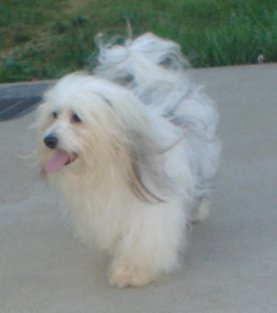Many Havanese lovers are unaware of their ability to change color. Unfortunately, it is impossible, by choosing a favorite Havanese puppy, to be sure that he will keep the color throughout his life.
This is Biscuit as a 5 week old pup, she is a silver parti color, (a parti color must have it’s coloring on it’s back broken with a second color somewhere. You can see she is black on her ears and her spot in the center of her body. This black will lighten to a silver by the time she is 2 (as you can see in the next photo’s) the silver change process is very slow in havanese, but shows up around 4 weeks of age in puppies.

This is the same dog, Biscuit. As a 4 year old in the picture, you can see she kept her silvering color and also got cream on her face as she aged. The cream was quite a surprise, since she showed no signs of cream as a puppy.
Havanese have more than a dozen genes responsible for color (pattern and shade). Several of them are responsible for changing the shade during the life of the animal.
If you have photos of the puppy’s parents at your disposal during different stages of their growing up, it is almost impossible to predict what color your dog will have in 2-3 years.
However, it should be borne in mind that the light color changes the least. A white puppy is very likely to remain white when it grows up. But if there are spots, then this rule does not work.
Regarding the Havanese with a sable color, the rule applies: the darker the color of the puppy, the more it will change when the dog grows up.
Also, under some conditions, the puppy’s color may become lighter over the years.
The color of the coat usually begins to change starting from the second week after birth. And after 2-3 years, the color stabilizes. Further, the color will not change even when your pet gets older. Havanese, as a rule, do not turn gray. However, the quality of the pet’s fur strongly depends on its care.
Changing the color of the coat for the Havanese is a distinctive feature of this breed. Therefore, treat this as a positive factor and enjoy changing the appearance of your pet, without forgetting to take photos. It will be very interesting to trace this wonderful feature in its coloring from the photo when the dog is in adulthood.